Monthly Archives: March 2017

 My niece, Liz Masterson, doesn’t realize what an inspiration she is to a lot of people, or if she does, she is just so not conceited, that she would never acknowledge that she knows. She is a journalism teacher at Kelly Walsh High School, and as such, she also teaches English, and puts out the yearbook. Her younger English students may or may not realize how much she does for them, but her journalism students, and the students she works with on the yearbook, know very well, how special she is. The friendships she has made with those students, and yes, I say friendships, have and will last for as long as they live. How many people keep in touch with and even spend time with their teachers after high school? Not very many, if any, but Liz is special. She treats them like the amazing people she knows they can become, when they are still students, and later when they start out in their lives, they remember that she was always there for them…cheering them on. There is no greater tribute a teacher can receive than to have a student say that if it wasn’t for this teacher, I might not have lived to my full potential. Liz has been that teacher to her students, and they have told her so.
My niece, Liz Masterson, doesn’t realize what an inspiration she is to a lot of people, or if she does, she is just so not conceited, that she would never acknowledge that she knows. She is a journalism teacher at Kelly Walsh High School, and as such, she also teaches English, and puts out the yearbook. Her younger English students may or may not realize how much she does for them, but her journalism students, and the students she works with on the yearbook, know very well, how special she is. The friendships she has made with those students, and yes, I say friendships, have and will last for as long as they live. How many people keep in touch with and even spend time with their teachers after high school? Not very many, if any, but Liz is special. She treats them like the amazing people she knows they can become, when they are still students, and later when they start out in their lives, they remember that she was always there for them…cheering them on. There is no greater tribute a teacher can receive than to have a student say that if it wasn’t for this teacher, I might not have lived to my full potential. Liz has been that teacher to her students, and they have told her so.
Another part of Liz’s job as the journalism teacher, is photographer, and she is an amazing photographer. She captures such precious moments in the students’ lives. Everything from sports, to team pictures, to dances, and other functions, have been captured by Liz’s lens…and in perfect detail. She has also taken many of the Senior pictures for the yearbook, including the family members who have gone through the ranks of high school. She has also taken many other family pictures, and recently, the pictures for our church’s website. Her photographic talents are endless and ever expanding. Liz stays up on techniques and styles, and so her photography changes with the times…becoming more amazing.

Liz has many interests, not the least of which is traveling, and of course, her babies…puppies, Luka, Scout, and Buffy, and her cat, Piper. She mothers those babies just like you would a child, and they love her like she is their mom. It is a beautiful relationship. They love her as much as she loves them. Liz has a well rounded, happy life, and she is an amazing inspiration to all who know her. Today is Liz’s birthday. Happy birthday Liz!! Have a great day!! We love you!!
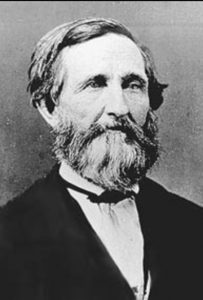 In the movies about the old west, you often see a gun fight. If someone got shot, the procedure to get the bullet out, was…well, painful. When we think of an operation, we think of a person being under anesthesia, and completely asleep during the entire procedure. In reality, prior to March 30, 1842, people who had to have an operation, had better have a strong constitution, because the best a doctor could do for them was to have them bite down on a stick. Now, this didn’t reduce the pain, but I suppose it lessened the noise level of the scream that the doctor knew was coming. I’m sure that surgery was seriously the last resort, and even often delayed longer than it should have been, simply because of the pain involved.
In the movies about the old west, you often see a gun fight. If someone got shot, the procedure to get the bullet out, was…well, painful. When we think of an operation, we think of a person being under anesthesia, and completely asleep during the entire procedure. In reality, prior to March 30, 1842, people who had to have an operation, had better have a strong constitution, because the best a doctor could do for them was to have them bite down on a stick. Now, this didn’t reduce the pain, but I suppose it lessened the noise level of the scream that the doctor knew was coming. I’m sure that surgery was seriously the last resort, and even often delayed longer than it should have been, simply because of the pain involved.
Enter, Dr Crawford Williamson Long, an American surgeon and pharmacist. Long was a bright child, graduating from the local academy at 14 years old, and continuing on to the University of Georgia in Athens. In 1835, he received his Masters Degree. Then, he began studying at Transylvania College in the fall of 1836 in Lexington, Kentucky. Long studied under Benjamin Dudley, a revered surgeon. He observed and participated in many surgeries and noted the effects of operating without anesthesia. Long transferred to the University of Pennsylvania in Philadelphia after spending only a year at Transylvania College, and was introduced to some of the most cutting edge medical technology of the time. He received his MD degree at the University of Pennsylvania in 1839.
After an 18 month internship in New York, Dr Long returned to Georgia. He took over a rural medical practice in Jefferson, Georgia in 1841. After observing the same physiological effects with Diethyl Ether that Humphry Davy had described for nitrous oxide in 1800, he used Ether for the first time on March 30, 1842 to remove a tumor from the neck of a patient, James M. Venable. He administered Sulfuric Ether on a towel and simply had the patient inhale. He performed many other surgeries using this technique over the next few years. Then, he introduced the technique to his obstetrics practice as well. Long subsequently removed a second tumor from Venable and used Ether as an anesthetic in amputations and childbirth. While Long’s use of Ether continued for quite a while, he didn’t immediately publish his findings. The results of these trials were eventually published in 1849 in The Southern Medical and Surgical Journal. It was a major advancement in surgical procedures.
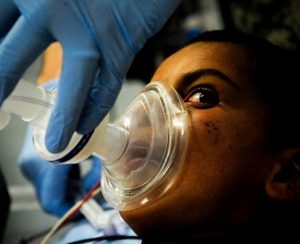 General anesthesia suppresses central nervous system activity and results in unconsciousness and total lack of sensation. Sedation suppresses the central nervous system to a lesser degree, inhibiting both anxiety and creation of long-term memories without resulting in unconsciousness. Of course, Ether is no longer used, because of the dangerous side effects, but many other types of anesthesia have been developed since Ether was used. I can’t imagine just how awful it would be to have surgery without anesthesia, and I for one am glad that it was developed. My shoulder surgery would have been horrible, if it had to be done without my arm being completely numb with a newer form of medicine that kept it numb, and me comfortable all that day.
General anesthesia suppresses central nervous system activity and results in unconsciousness and total lack of sensation. Sedation suppresses the central nervous system to a lesser degree, inhibiting both anxiety and creation of long-term memories without resulting in unconsciousness. Of course, Ether is no longer used, because of the dangerous side effects, but many other types of anesthesia have been developed since Ether was used. I can’t imagine just how awful it would be to have surgery without anesthesia, and I for one am glad that it was developed. My shoulder surgery would have been horrible, if it had to be done without my arm being completely numb with a newer form of medicine that kept it numb, and me comfortable all that day.
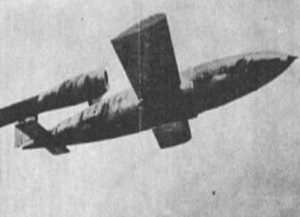
 Every time I research one of the weapons used in war, I am more and more stunned by the hatred that brings the need to destroy one another. During World War II, Hitler continuously created…or rather had his scientists create newer, more powerful, and more devastating bombs. His V-1 missile, also known as the V-1 flying bomb, or in German: Vergeltungswaffe 1, meaning “Vengeance Weapon 1” became known to the Allies as the buzz bomb, or doodlebug. In Germany it was known as Kirschkern, or cherrystone, and as Maikäfer or maybug. It was an early cruise missile, and also the first production aircraft to use a pulsejet for power.
Every time I research one of the weapons used in war, I am more and more stunned by the hatred that brings the need to destroy one another. During World War II, Hitler continuously created…or rather had his scientists create newer, more powerful, and more devastating bombs. His V-1 missile, also known as the V-1 flying bomb, or in German: Vergeltungswaffe 1, meaning “Vengeance Weapon 1” became known to the Allies as the buzz bomb, or doodlebug. In Germany it was known as Kirschkern, or cherrystone, and as Maikäfer or maybug. It was an early cruise missile, and also the first production aircraft to use a pulsejet for power.
The V-1 was developed at Peenemünde Army Research Center by the Nazi German Luftwaffe during World War II. During initial development it was known by the codename “Cherry Stone.” It was first of the so-called “Vengeance weapons” (V-weapons or Vergeltungswaffen) series designed for terror bombing of London. As one of my readers, Greg (sorry, I don’t know his last name) pointed out to me, it was one of the V weapons…the V-3 to be exact that would ultimately cause the death of Joseph Kennedy, but that is a story for another day. The range of the V-1 missile was limited, and so the thousands of V-1 missiles launched into England were fired from launch facilities along the French (Pas-de-Calais) and Dutch coasts. The first V-1 was launched at London on 13 June 1944, one week after, and actually prompted by the successful Allied landings in Europe. At its peak, more than one hundred V-1s a day were fired at south-east England, 9,521 in total, decreasing in number as sites were overrun until October 1944, when the last V-1 site in range of Britain was overrun by Allied forces. After this, the V-1s were directed at the port of Antwerp and other targets in Belgium, with 2,448 V-1s being launched. The attacks stopped only a month before the war in Europe ended, when the last launch site in the Low Countries was overrun on March 29, 1945.
It took a V-1 about 15 minutes to travel from its launch pad in Calais, France to the heart of London…a distance of nearly 95 miles. Nearly 10,000 V-1s were launched from sites in Northern France over an 80 day period beginning in June 1944. Their targets included London, as well as other cities in southern England. At the peak of the bombing, more than 100 rockets were hitting Britain daily. Casualties climbed to 22,000 people, with more than 6,000 of them fatalities. Hitler hoped his new weapons would crush British morale, bringing 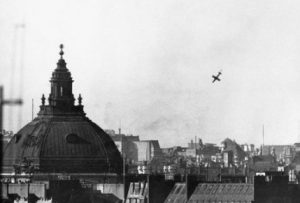
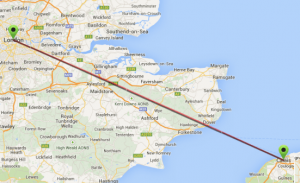 surrender. More V-1s would later be fired from inside Germany itself at Liege and the port of Antwerp. Hitler had underestimated the British, however. The British operated an arrangement of air defenses, including anti-aircraft guns and fighter aircraft, to intercept the bombs before they reached their targets as part of Operation Crossbow, while the launch sites and underground V-1 storage depots were targets of strategic bombings.
surrender. More V-1s would later be fired from inside Germany itself at Liege and the port of Antwerp. Hitler had underestimated the British, however. The British operated an arrangement of air defenses, including anti-aircraft guns and fighter aircraft, to intercept the bombs before they reached their targets as part of Operation Crossbow, while the launch sites and underground V-1 storage depots were targets of strategic bombings.
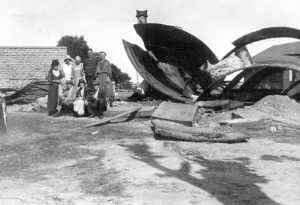
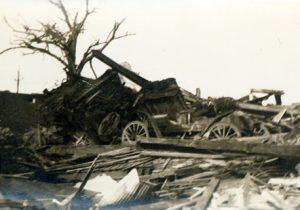 Over the centuries, tornadoes have managed to wreak havoc on various areas of the world, not to mention the thousands of lives they have taken. With advancements in the early warning systems and on weather conditions, the deaths have decreased, but in 1920, no such systems existed. It was March 28, 1920…Palm Sunday, when at least 37 tornadoes, 31 of which were significant, raged across the Midwest and Deep South states. The tornadoes left more than 380 dead, as well as at least 1,215 injured. Many communities and outlying farmers alike were caught off guard as the storms moved to the northeast at speeds that reached over 60 miles per hour. Georgia saw most of the fatalities with over 200 deaths. Indiana had 56 deaths and Ohio had 55, while the other states saw fewer fatalities. Without ways to monitor the tornadoes, very little is known about many of the specific tornadoes that occurred.
Over the centuries, tornadoes have managed to wreak havoc on various areas of the world, not to mention the thousands of lives they have taken. With advancements in the early warning systems and on weather conditions, the deaths have decreased, but in 1920, no such systems existed. It was March 28, 1920…Palm Sunday, when at least 37 tornadoes, 31 of which were significant, raged across the Midwest and Deep South states. The tornadoes left more than 380 dead, as well as at least 1,215 injured. Many communities and outlying farmers alike were caught off guard as the storms moved to the northeast at speeds that reached over 60 miles per hour. Georgia saw most of the fatalities with over 200 deaths. Indiana had 56 deaths and Ohio had 55, while the other states saw fewer fatalities. Without ways to monitor the tornadoes, very little is known about many of the specific tornadoes that occurred.
Early in the morning of March 28th, severe thunderstorms began developing in Missouri, moving quickly to the northeast towards Chicago, Illinois. The first tornado injured five people 35 miles southeast of Springfield, Missouri, in Douglas County. This first tornado was a warning of things to come as the morning went on and the atmosphere began to destabilize, due to the abundance of sunshine that preceded the cold front in the warm sector, which covered the lower Great Lakes region extending southward, well past the Ohio River Valley. According to meteorologist and weather historian Charles Merlin Umpenhour, the climatic conditions on Palm Sunday 1920 were favorable for all the atmospheric ingredients to come together that were needed to create the classic setup for long-track tornadoes. The forecasting…or communications technology and public awareness about Severe Weather was nearly nonexistent in 1920. That technology would not begin for another 33 years, when the US Weather Bureau implemented its Public Watch.
The residents of the Great Lakes region and Ohio Valley areas, had as their only source of weather information, the rather vague forecasts that were issued in the local newspaper the day before or by word of mouth. The use of the word “tornado” was strictly prohibited in public weather forecasting until the 1950s because of the fear and panic it might cause. This policy would come under fire in the years to come especially after the Tri-State Tornado in 1925 that stands today as the deadliest tornado in American history…as it should have. It would be insane not to let the people know of such deadly weather, simply because someone might get scared. That really is the point of it. To “scare” people into action!! It saves lives.
Weather forecasters and the public alike in the Chicago, Dayton, Fort Wayne, Lansing, South Bend, and Toledo areas were unaware of the likelihood of a significant tornado outbreak that would follow a beautiful Palm Sunday afternoon. The weather maps in use in March 1920 showed a rather large and deep cyclone over northern Iowa, and they knew it would be moving across central Lower Michigan by nightfall with a cold front right behind it. Meteorologists knew rain showers, and very likely thundershowers, were a good possibility, but were unaware that the helicity (which is a property of a moving fluid which represents the potential for helical flow…or a flow which follows the pattern of a corkscrew to evolve. Helicity is proportional to the strength of the 
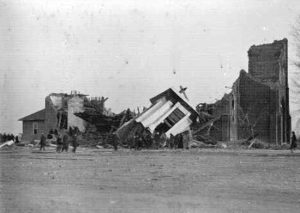 flow, the amount of vertical wind shear, and the amount of turning in the flow known as a vorticity), the lifted index, and upper level winds which were being guided by a strong jet stream with a probable negative tilt. When all that is put together, it creates conditions that are favorable for the development of tornadoes, and thereby, a seriously dangerous situation. Had the people known all that in 1920, perhaps most of the lives lost, could have been saved.
flow, the amount of vertical wind shear, and the amount of turning in the flow known as a vorticity), the lifted index, and upper level winds which were being guided by a strong jet stream with a probable negative tilt. When all that is put together, it creates conditions that are favorable for the development of tornadoes, and thereby, a seriously dangerous situation. Had the people known all that in 1920, perhaps most of the lives lost, could have been saved.
 My niece, Amanda Reed joined our family in 2002, when her dad, Mike Reed married my sister, Caryl Spencer. She was a 15 year old high school student…just a girl really. Over the years I have watched as Amanda went from a teenaged girl to the woman she is today. The most important people in her life are her daughter, Jaydn Mortensen and boyfriend, Sean Mortensen. Being a mom has been an amazing journey for her, and one she will always cherish. Jaydn keeps her parents busy with her different activities, and they in turn keep her busy with all of their activities. This is one of the most active families I have ever known. From motorcycles, to 4 wheelers, to snowmobiles, to Jaydn’s horses…the outdoors is their second home.
My niece, Amanda Reed joined our family in 2002, when her dad, Mike Reed married my sister, Caryl Spencer. She was a 15 year old high school student…just a girl really. Over the years I have watched as Amanda went from a teenaged girl to the woman she is today. The most important people in her life are her daughter, Jaydn Mortensen and boyfriend, Sean Mortensen. Being a mom has been an amazing journey for her, and one she will always cherish. Jaydn keeps her parents busy with her different activities, and they in turn keep her busy with all of their activities. This is one of the most active families I have ever known. From motorcycles, to 4 wheelers, to snowmobiles, to Jaydn’s horses…the outdoors is their second home.
In 2005, shortly after graduating from high school, Amanda went to work at the Rawlins National Bank as a teller. Most kids right out of high school go from job to job, but then most of them aren’t hired at a bank, I suppose. Nevertheless, Amanda has been a faithful and after 12 years, a long term employee. Now, her hard  work and loyalty is paying off. Recently, Amanda was promoted to BSA Officer at the Rawlins National Bank. Now I had no idea what that was, so I decided to look it up. This is what I found…”Congress passed the Bank Secrecy Act in 1970 as the first laws to fight money laundering in the United States. The BSA requires businesses to keep records and file reports that are determined to have a high degree of usefulness in criminal, tax, and regulatory matters. The documents filed by businesses under the BSA requirements are heavily used by law enforcement agencies, both domestic and international to identify, detect and deter money laundering whether it is in furtherance of a criminal enterprise, terrorism, tax evasion or other unlawful activity.”
work and loyalty is paying off. Recently, Amanda was promoted to BSA Officer at the Rawlins National Bank. Now I had no idea what that was, so I decided to look it up. This is what I found…”Congress passed the Bank Secrecy Act in 1970 as the first laws to fight money laundering in the United States. The BSA requires businesses to keep records and file reports that are determined to have a high degree of usefulness in criminal, tax, and regulatory matters. The documents filed by businesses under the BSA requirements are heavily used by law enforcement agencies, both domestic and international to identify, detect and deter money laundering whether it is in furtherance of a criminal enterprise, terrorism, tax evasion or other unlawful activity.”
Now that sounded almost like a secret agent job to me, but it is somewhat different than that in reality. A big part of Amanda’s new position is that she is the supervisor over the teller line. That in itself is pretty amazing for a person of just 31 years of age, but as we all know, the teller supervisor can’t just  stand around making sure that everyone works. They have other responsibilities. Part of her job has to do with deposits that might look questionable. The law requires her to report cash payments over $10,000 received in a trade or business, and report foreign bank and financial accounts, just to name a couple. Now I don’t know how much of that Amanda might run into in Rawlins, Wyoming, but she would have to know those laws in the event that she did. All this sounds more and more like secret agent stuff to me, but I’m sure it really isn’t. Nevertheless, it is pretty impressive for a woman of just 31 years, and Amanda, we are very proud of you. Today is Amanda’s birthday. Happy birthday Amanda!! Have a great day!! We love you!!
stand around making sure that everyone works. They have other responsibilities. Part of her job has to do with deposits that might look questionable. The law requires her to report cash payments over $10,000 received in a trade or business, and report foreign bank and financial accounts, just to name a couple. Now I don’t know how much of that Amanda might run into in Rawlins, Wyoming, but she would have to know those laws in the event that she did. All this sounds more and more like secret agent stuff to me, but I’m sure it really isn’t. Nevertheless, it is pretty impressive for a woman of just 31 years, and Amanda, we are very proud of you. Today is Amanda’s birthday. Happy birthday Amanda!! Have a great day!! We love you!!
 Most people in the United States consider driving a car a right, but in reality it is a privilege, and must be earned. At 15 a child may obtain a permit to drive with a licensed driver by taking a written exam. Then in a year, or at age 16, they have to take a written and driving test to get a license. The driving test can be waived if they have completed driver’s education. The exams are pretty basic, and in this country, most people pass the test on the first try, and if not on the first try, most pass on the second try. The first driving test was administered in 1899 Chicago and New York City. Massachusetts and Missouri were the first US states to require a license for driving a motor vehicle in 1903. Pennsylvania’s 1909 licensing laws were the first to give an age restriction “18 years of age” and the first state to allow 16 year olds to drive, if they were accompanied by a licensed driver, was Connecticut in 1921. I’m sure that prior to these times most people didn’t have one of the new fangled automobiles, so a license was not needed.
Most people in the United States consider driving a car a right, but in reality it is a privilege, and must be earned. At 15 a child may obtain a permit to drive with a licensed driver by taking a written exam. Then in a year, or at age 16, they have to take a written and driving test to get a license. The driving test can be waived if they have completed driver’s education. The exams are pretty basic, and in this country, most people pass the test on the first try, and if not on the first try, most pass on the second try. The first driving test was administered in 1899 Chicago and New York City. Massachusetts and Missouri were the first US states to require a license for driving a motor vehicle in 1903. Pennsylvania’s 1909 licensing laws were the first to give an age restriction “18 years of age” and the first state to allow 16 year olds to drive, if they were accompanied by a licensed driver, was Connecticut in 1921. I’m sure that prior to these times most people didn’t have one of the new fangled automobiles, so a license was not needed.
The United Kingdom made the move to require testing on March 24, 1934, and the requirements were a little different than in the United States. The test must be taken in order to receive a full license, and also to add full entitlements to an existing license. The test varies, depending on the class of vehicle that is to be driven, and is administered by the Driver and Vehicle Standards Agency or DVSA, in Great Britain and the Driver and Vehicle Agency, or DVA in Ireland. Those parts of the program seem to be just like here in the United States, but from there on out, there is a pretty big difference. In the United Kingdom, the minimum age at which one can take a driving test is currently 16 for mopeds and 17 for cars, with an exception allowed at 16 for those on the higher/enhanced rate of the mobility component. In addition to a driving licence, a CBT certificate may be required before a moped or motorcycle is ridden.
In Great Britain around 1.6 million people take the practical car test per year. Approximately 43% of those who take it pass the test, and the theory test has a pass rate of about 51.6%. Now I don’t know what you think, but I think the kids in this country would be pretty upset if only half of those who took the test got to actually drive  legally. Then again, maybe kids would study harder for the test in that case. I can’t tell you how many times I have heard a kid say, “It’s all common sense.” My thought is, “What wealth of knowledge about driving a car is a 15 year old, who has never driven one, going to have.” The answer is obvious…to the parents anyway. If they don’t study, they will likely not pass, but what of the people of Great Britain and Ireland. They know the test is difficult. My guess is that they do study, but that the test is a much more advanced version than those in the United States. Maybe it’s because they want it to be more than just common sense. I’m not saying our tests are too easy…but it’s something to consider when you look at the statistics.
legally. Then again, maybe kids would study harder for the test in that case. I can’t tell you how many times I have heard a kid say, “It’s all common sense.” My thought is, “What wealth of knowledge about driving a car is a 15 year old, who has never driven one, going to have.” The answer is obvious…to the parents anyway. If they don’t study, they will likely not pass, but what of the people of Great Britain and Ireland. They know the test is difficult. My guess is that they do study, but that the test is a much more advanced version than those in the United States. Maybe it’s because they want it to be more than just common sense. I’m not saying our tests are too easy…but it’s something to consider when you look at the statistics.
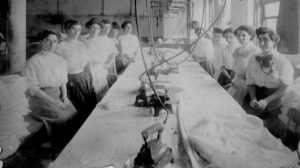 Fire safety measures have vastly improved over the years, but in the early 1900s, no such safety measures existed. That would prove deadly on March 25, 1911 in New York City. People didn’t really know about materials that were more flammable, other than wood. Nevertheless, wood was the main material used in buildings, and in fact, still is today. The Triangle Shirtwaist Company factory was owned by Max Blanck and Isaac Harris. It was located in the top three floors of the Asch Building, on the corner of Greene Street and Washington Place, in Manhattan. These days that is not really a place we would expect to see a factory…much less a sweatshop, but the Triangle Shirtwaist Company’s factory was a true sweatshop. They employed mostly young immigrant women who worked in a cramped space at lines of sewing machines. Nearly all the workers were teenaged girls who did not speak English and made only about $15 per week working 12 hours a day, every day.
Fire safety measures have vastly improved over the years, but in the early 1900s, no such safety measures existed. That would prove deadly on March 25, 1911 in New York City. People didn’t really know about materials that were more flammable, other than wood. Nevertheless, wood was the main material used in buildings, and in fact, still is today. The Triangle Shirtwaist Company factory was owned by Max Blanck and Isaac Harris. It was located in the top three floors of the Asch Building, on the corner of Greene Street and Washington Place, in Manhattan. These days that is not really a place we would expect to see a factory…much less a sweatshop, but the Triangle Shirtwaist Company’s factory was a true sweatshop. They employed mostly young immigrant women who worked in a cramped space at lines of sewing machines. Nearly all the workers were teenaged girls who did not speak English and made only about $15 per week working 12 hours a day, every day.
In 1911, the Asch Building had four elevators with access to the factory floors, but only one was fully operational and the workers had to file down a long, narrow corridor in order to reach it. There were also two stairways down to the street, but one was locked from the outside to prevent stealing and the door of the other only opened inward. The fire escape was so narrow that it would have taken hours for all the workers to use it, even in the best of circumstances…in an emergency, it was almost useless. Pretty much everyone knew about the danger of fire in factories like the Triangle Shirtwaist Company factory, but high levels of corruption in both the garment industry and city government ensured that no useful precautions were taken to prevent fires. The 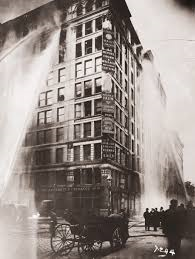 problem was that making the factories safe cost money, and dug into the profits, so the owners didn’t want to do what was necessary to save lives. The Triangle Shirtwaist Company factory’s owners were known to be particularly anti-worker in their policies and had played a critical role in breaking a large strike by workers the previous year.
problem was that making the factories safe cost money, and dug into the profits, so the owners didn’t want to do what was necessary to save lives. The Triangle Shirtwaist Company factory’s owners were known to be particularly anti-worker in their policies and had played a critical role in breaking a large strike by workers the previous year.
On March 25, a Saturday afternoon, there were 600 workers at the factory when a fire began in a rag bin. The manager attempted to use the fire hose to extinguish it, but was unsuccessful. The hose was rotted and its valve was rusted shut. They were at the mercy of the raging inferno. The fire grew and the workers panicked. They tried to exit the building by the elevator, but it could only hold 12 people and the operator was able to make just four trips before it broke down due to the heat and flames. In a desperate attempt to escape the flames. The girls left behind waiting for the elevator plunged down the shaft to their deaths. The girls who fled by way of the stairwells also met awful fates. When they found a locked door at the bottom of the stairs, many were burned alive. In all, 145 workers between the ages of 14 and 43, mostly women and mostly in their teens and early twenties, died that day. Six of them would not be identified until February, 2011…100 years later.
Once the fire was reported, the firefighters tried to put it out, but their ladders would only reach the seventh floor. The fire was on the eighth floor. When escape was proven to be impossible, the girls, desperate to escape the searing heat and flames, began to jump. The bodies of those who jumped landed on the hoses, hampering the flow. The firemen got out nets to catch the girls, but they jumped three at a time, tearing the nets. The nets were of no real help. Within 18 minutes, it was all over. Of the dead, 49 workers had burned to death or been suffocated by smoke, 36 were dead in the elevator shaft and 58 died from jumping to the sidewalks. Two 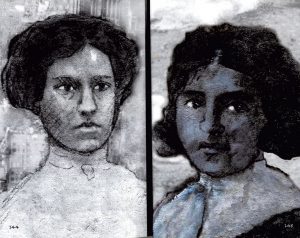 more died later from their injuries. The workers’ union set up a march on April 5 on New York’s Fifth Avenue to protest the conditions that had led to the fire. It was attended by 80,000 outraged people. Despite a good deal of evidence that the owners and management had been horribly negligent in the fire, a grand jury failed to indict them on manslaughter charges. The tragedy did result in some good, however. The International Ladies Garment Workers Union was formed in the aftermath of the fire and the Sullivan-Hoey Fire Prevention Law was passed in New York that October. Both were crucial in preventing similar disasters in the future. Still, I think that it will take the memory of the victims of corruption to ever really inspire people to change the way things are.
more died later from their injuries. The workers’ union set up a march on April 5 on New York’s Fifth Avenue to protest the conditions that had led to the fire. It was attended by 80,000 outraged people. Despite a good deal of evidence that the owners and management had been horribly negligent in the fire, a grand jury failed to indict them on manslaughter charges. The tragedy did result in some good, however. The International Ladies Garment Workers Union was formed in the aftermath of the fire and the Sullivan-Hoey Fire Prevention Law was passed in New York that October. Both were crucial in preventing similar disasters in the future. Still, I think that it will take the memory of the victims of corruption to ever really inspire people to change the way things are.

 It’s been a year now, since my grand nephew, Weston Moore obtained his driver’s license. It’s still hard for me…and his parents, to believe that he is 17 years old today. The years have flown by, and what seems like just yesterday, is now far in the past. These days, Weston has his own car, and is pretty much self sufficient…with the exception, of “What’s for dinner Mom!” I suppose he needs her for more than that, but when a parent has teenaged boys, food is the number one priority.
It’s been a year now, since my grand nephew, Weston Moore obtained his driver’s license. It’s still hard for me…and his parents, to believe that he is 17 years old today. The years have flown by, and what seems like just yesterday, is now far in the past. These days, Weston has his own car, and is pretty much self sufficient…with the exception, of “What’s for dinner Mom!” I suppose he needs her for more than that, but when a parent has teenaged boys, food is the number one priority.
No longer is Weston a baby, crawling around on the floor. No  longer is he the little boy in grade school, or even middle school. These days Weston is a tall young man, with feet the size of boats!! They literally make his dad, Steve Moore’s feet look small…which they aren’t. Weston is busy participating in track right now, where he is in shot put and discus. He is very serious about track, and works very hard at it. He sprained his ankle in his “0” hour class last week, but if you think that stopped him for going to track…you would be very wrong. He still managed to make it to track and participate!! I guess it’s all in what is important, and apparently pain is overrated, and sports are a necessity.
longer is he the little boy in grade school, or even middle school. These days Weston is a tall young man, with feet the size of boats!! They literally make his dad, Steve Moore’s feet look small…which they aren’t. Weston is busy participating in track right now, where he is in shot put and discus. He is very serious about track, and works very hard at it. He sprained his ankle in his “0” hour class last week, but if you think that stopped him for going to track…you would be very wrong. He still managed to make it to track and participate!! I guess it’s all in what is important, and apparently pain is overrated, and sports are a necessity.
Weston has a part-time job, working at with his mom, Machelle Moore, at Bighorn Design Studio in Powell, Wyoming. His job is to clean the screens after a design is placed. He is doing so well at his job, that they plan is to teach him to do several other things that the full-time employees simply don’t have time to get done. When school lets out for the summer, Weston has the offer of a new opportunity. The place that his grandpa, Lynn Cook retired from wants him to go to work for them. It will be a great opportunity for him, and I know he will learn a lot, and make some good money, which as we know, every teenager needs…for 
 gas, if nothing else…oh, and of course, for dating.
gas, if nothing else…oh, and of course, for dating.
Weston has grown up to be a lot like his grandpa, Lynn Cook. He is tall like Lynn, as well as his own dad. He has big feet like his grandpa, and he likes to joke around and make people laugh…just like his grandpa!! I’m sure he is a great jokester, and my guess is that he has learned a bunch of his material from…you guessed it, his grandpa. Weston may be a funny guy, but he also has a soft heart, which I have seen in him whenever he is visiting. Many kids don’t really like to hug the great aunts, but Weston always does, and it melts this great aunt’s heart for sure. Today is Weston’s 17th birthday. Happy birthday Weston!! Have a great day!! We love you!!
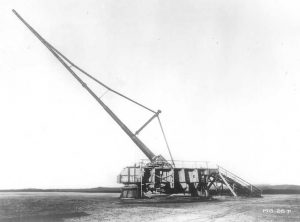
 It seems as if the nations will never be satisfied until they have a new and stronger weapon that will easily destroy a massive amount of people in one shot. Wars are a part of life here on Earth, and will be until the end of time, so we might as well get used to that fact. World War I was not a different time when it comes to weapons of war, in fact on March 23, 1918 at 7:20am, an explosion took place in the Place de la Republique in Paris, and it hailed the first attack of a new German gun. The Pariskanone, Paris-Geschütz, or Paris gun, as it came to be known, was manufactured by Krupps. The Pariskanone was 210mm, with a 118-foot-long barrel. It could fire a shell an impressive distance of some 130,000 feet…25 miles into the air. Three of them fired on Paris that day from a gun site at CrÉpy-en-Laonnaise, a full 74 miles away. The city of Paris was reeling. Paris had withstood all earlier attempts at its destruction, including scattered bombings, but this would be different. It was first thought by the Paris Defense Service, that the city was being bombed, but soon they determined that it was actually being hit by artillery fire. It was a previously unimagined situation. I’m sure everyone wondered how the Germans could have made such a weapon.
It seems as if the nations will never be satisfied until they have a new and stronger weapon that will easily destroy a massive amount of people in one shot. Wars are a part of life here on Earth, and will be until the end of time, so we might as well get used to that fact. World War I was not a different time when it comes to weapons of war, in fact on March 23, 1918 at 7:20am, an explosion took place in the Place de la Republique in Paris, and it hailed the first attack of a new German gun. The Pariskanone, Paris-Geschütz, or Paris gun, as it came to be known, was manufactured by Krupps. The Pariskanone was 210mm, with a 118-foot-long barrel. It could fire a shell an impressive distance of some 130,000 feet…25 miles into the air. Three of them fired on Paris that day from a gun site at CrÉpy-en-Laonnaise, a full 74 miles away. The city of Paris was reeling. Paris had withstood all earlier attempts at its destruction, including scattered bombings, but this would be different. It was first thought by the Paris Defense Service, that the city was being bombed, but soon they determined that it was actually being hit by artillery fire. It was a previously unimagined situation. I’m sure everyone wondered how the Germans could have made such a weapon.
Before the day was over, the shelling had killed 16 people and wounded 29 more. The Germans continued the shelling of that year in several phases between March 23 and August 9, 1918. Over that time, the gun caused a total of 260 deaths in Paris. It was a low number due to the fact that the residents of Paris quickly learned to avoid gathering in large groups during periods of shelling. With less people in each area, the casualties were limited substantially. Nevertheless, the weapon had a terrifying effect on the people and a horrific impact on property in the areas of the shelling. Almost all information about the Pariskanone, one of the most sophisticated weapons to emerge out of World War I, disappeared after the war ended. Later, the Nazis tried 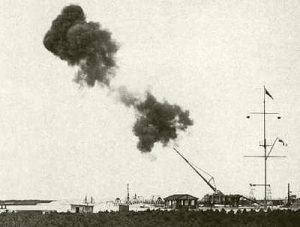
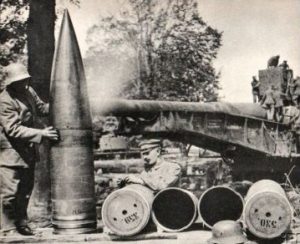 without success to reproduce the gun from the few pictures and diagrams that remained. Copies were deployed in 1940 against Britain across the English Channel, but failed to cause any significant damage….a good thing for the people of the Britain at that time. When I look at the pictures of the weapon, I am reminded of the old “Wild, Wild, West” show. There always seemed to be some strange new fangled weapon of destruction in use there too.
without success to reproduce the gun from the few pictures and diagrams that remained. Copies were deployed in 1940 against Britain across the English Channel, but failed to cause any significant damage….a good thing for the people of the Britain at that time. When I look at the pictures of the weapon, I am reminded of the old “Wild, Wild, West” show. There always seemed to be some strange new fangled weapon of destruction in use there too.
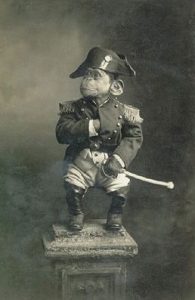
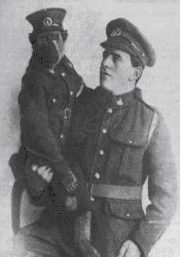 When World War I broke out, many young men were called into service. It is a common part of war…one we all know about, and most parents dread. World War I was unique in one way, however. There was a soldier who went to war who was different. He was not different in the way he served exactly, but rather in some other very obvious ways. His speech was different. His mentality was somewhat different, and his looks were different. I’m not being discriminatory, but simply stating a fact. His name was Jackie, and he was different because he was a monkey, well actually, he was a Chacma baboon (Papio ursinus). Jackie was found in August 1915 near the Marr’s family farm in Villeria, Pretoria, South Africa by Albert Marr and soon became a beloved pet.
When World War I broke out, many young men were called into service. It is a common part of war…one we all know about, and most parents dread. World War I was unique in one way, however. There was a soldier who went to war who was different. He was not different in the way he served exactly, but rather in some other very obvious ways. His speech was different. His mentality was somewhat different, and his looks were different. I’m not being discriminatory, but simply stating a fact. His name was Jackie, and he was different because he was a monkey, well actually, he was a Chacma baboon (Papio ursinus). Jackie was found in August 1915 near the Marr’s family farm in Villeria, Pretoria, South Africa by Albert Marr and soon became a beloved pet.
When the war started and the young men were drafted, Albert was no exception. The thing is that Albert couldn’t stand the thought of leaving his beloved pet at home. Albert was assigned to service at Potchefstroom in the North West province of South Africa as private number 4927 for the newly formed 3rd Transvaal Regiment of the 1st South African Infantry Brigade on the 25th August 1915. He approached his superiors and requested that Jackie be allowed to go with him and amazingly was given permission. I’m sure that seems as odd to you as it did to me, but it goes further. Once enlisted Jackie was given a special uniform complete with buttons, a cap, regimental badges, a pay book and his own rations. He was a true member of the regiment, but that doesn’t mean he was accepted as a part of it…at first anyway. The other members of the regiment initially ignored Jackie, but like most people around a monkey, or in this case, baboon, it was hard to ignore him for very long. Jackie soon became the official mascot of the 3rd Transvaal Regiment. Jackie took his duties very seriously, however. He wasn’t there just to eat and fool around!
Jackie was very smart, and when he saw a superior officer passing, he would stand to attention and even provide them with the correct salute. He would light cigarettes for his comrades in arms and was, without a doubt, the best sentry around, due to his great senses of hearing and smelling which allowed him to be able to detect any enemy long before any of his other army mates could even notice their approach. He wasn’t a coddled pet protected for the battles either. Jackie spent three years in the front line amongst the trenches of France and Flanders in Europe. During the Senussi Campaign on 26 February 1916 in Egypt, Jackie’s beloved Albert got wounded on his shoulder by an enemy bullet. Jackie stayed beside him until the stretcher bearers arrived, licking the wound and doing what he could to comfort his friend.
Albert and Jackie both held the rank of private, and in April of 1918, both got injured in the Passchendaele area in Belgium during a heavy fire. With explosions surrounding them, Jackie was seen trying to get some protection by building a little fortress of stones around himself. He didn’t manage to finish his little safe area soon enough, and was hit by a chunk of shrapnel from a shell explosion nearby, which also injured Albert. Jackie’s right leg was seriously wounded and later had to be amputated. Jackie and Albert both made a full recovery and shortly before the armistice, Jackie was promoted to corporal, and awarded a medal for valor.
At the end of April, Jackie was officially discharged at the Maitland Dispersal Camp, Cape Town, South Africa, while wearing on his arm a gold wound stripe and three blue service chevrons indicating three years of frontline service. He was given a parchment discharge paper, a military pension and a Civil Employment Form for 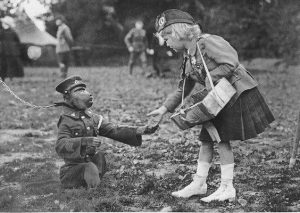
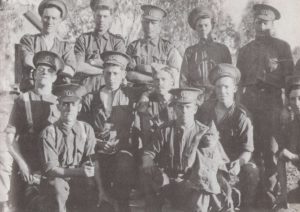 discharged soldiers. After his service, Jackie returned to the Marr’s farm where he lived until May 22, 1921…a sad day for all who knew him. Albert Marr lived until the age of 84 and died in Pretoria in August 1973. Jackie was an amazing Chacma Baboon who, because of a fateful connection, ended up as the only monkey to reach the rank of Corporal of the South African Infantry and fight in Egypt, Belgium and France during World War I. Now that’s amazing!!!
discharged soldiers. After his service, Jackie returned to the Marr’s farm where he lived until May 22, 1921…a sad day for all who knew him. Albert Marr lived until the age of 84 and died in Pretoria in August 1973. Jackie was an amazing Chacma Baboon who, because of a fateful connection, ended up as the only monkey to reach the rank of Corporal of the South African Infantry and fight in Egypt, Belgium and France during World War I. Now that’s amazing!!!

